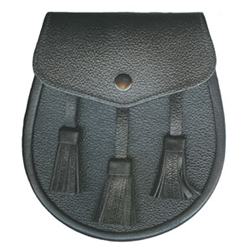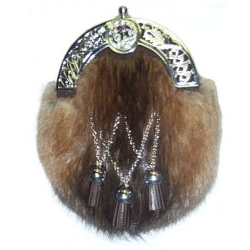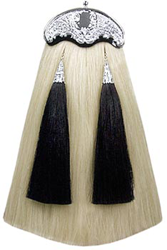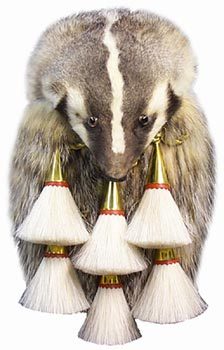
Best viewed in
Internet Explorer
PDF
Back to

Updated
06/28/2013 |
The Sporran
With the kilt, a sporran is a real necessity.
A Sporran is a pouch (the word is simply the
Scottish Gaelic for 'purse'). The official Band sporran is the
issued black leather “day” sporran without cantle. The top of the
sporran should be worn a hand’s breadth below the belt buckle or just
below the bottom of the waistcoat.
Now a decorative
part of Highland dress, it was originally an everyday practical item.
Made of leather or fur, it usually has more or less elaborate silver or
other ornamentation, especially on the clasp or hanger. It is worn on a
chain or belt around the waist, allowing the sporran to lie below the
waist of the person wearing a kilt.
Since the
traditional kilt does not have pockets, the sporran serves as a wallet
and container for any other necessary personal items (such as a
hip-flask). It is essentially a survival of the common European medieval
belt-pouch, superseded elsewhere as clothing came to have pockets, but
continuing in the Scottish Highlands because of the lack of these
accessories in traditional dress.
The sporran also
protects a person's decency. This was originally because the ancient
'great plaid' (Gaelic breacan an fhèilidh), formed of a long
draped cloth, had a gap at the front, and in more modern times because
the kilt is traditionally worn without undergarments. Historically, the
sporran was used to carry a day's rations.
There are several categories of sporrans, each with their proper attire:
|



 |
Day
Sporrans", like we wear in the Band, are usually simple
brown or black leather pouches with little adornment. These
"day" sporrans often have three leather tassels and
some Celtic knots embossed in the leather. Traditionalists
prefer brown or buff-colored sporrans, belts, and shoes for
day wear.
Dress Sporrans" are larger than the day variety, and are
more ornate. Victorian examples were often ostentatious, and
very different from the simple leather pouch of the 17th or
18th centuries. They usually have chrome or silver cantles
trimming the top of the pouch and a fur-covered face with
fur or hair tassels. The cantle may contain intricate
filigree or etchings of Celtic knots. The top of the cantle
may have a set stone, jewel, or emblems.
"Military Sporrans" may be worn with regimental attire.
Pipers will often wear the most flamboyant sporrans with
long horsehair that swishes from side to side as the piper
marches.
New legislation in
the European Union to protect vulnerable species could
affect kilt wearers, who may need a license to show that
sporrans made later than 1994 do not come from endangered or
illegally killed animals. The law is aimed at protecting
wild animals such as badgers, otters, hedgehogs and wild
cats.
Silver-mounted sporrans should be
reserved for more formal occasions. Plain leather or animal
masked sporrans are appropriate for daywear and,
interestingly enough, the animal masked sporran is one of
the few all-purpose sporrans that can be worn with the most
formal dress or the most informal wear.
One item of interest is that when
a gentleman is dressed in Highland attire and dances with a
lady, he should move the sporran to his left hip. This, of
course, is desirable when you are dancing cheek to cheek.
For Scottish country dancing, you may want to take up your
sporran belt a couple of notches, especially if you are
wearing an animal head sporran. You wouldn't want the bugger
flying across the room scaring the ladies half to death.
The sporran should also be moved
to an unencumbered hip when sitting down to the table. This
removes the sporran from harm's way so you don't spill on it
and makes your lap unencumbered for a napkin. In general,
it's just considered good manners. I once observed a man
sitting down to a table at a formal dinner and forgot to
move his badger sporran and, surprisingly, got a startled
response from the ladies at the table and when he looked
down, the badger appeared to be peering over the edge of the
table at the food. |
|




